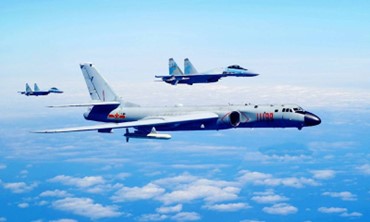
PLA Air Force: Significant Air Power – Time India Must Act

Like the Americans and the Russians, China realised very early that one who controls the aerospace, controls this planet. They began setting up aircraft building plants, initially with the help of the Soviet Union, and later during their honeymoon with the Americans, they could get better technologies. As they began becoming an economic power, they started aeronautical research and development in a big way. In parallel they made leaps into space.
Today PLA Air Force (PLAAF) fast transiting from a tactical, army-centric, to an air force with a global reach. The state-owned Aviation Industry Corporation of China (AVIC) is developing and producing state-of-the-art airborne platforms and is fast catching up with the best in the world. PLAAF has also reoriented its flying training and tactics. There is much greater emphasis on technological support even for operations. As Xi Jinping drives to create PLA into a “world-class” military, the PLAAF is evolving its operational doctrine, missions and roles, including concentrating on long-range precision strikes, and giving higher importance to personnel development. It is building specialisation for offensive operations, air defence, army support, reconnaissance, early-warning, and surveillance, information operations, and strategic transport forces. PLAAF also wants “integrated air and space capabilities and coordinated offensive and defensive operations.” Even though the space-based assets went under the Strategic Support Force (SSF), most PLAAF platforms now use of space-based systems. The newer fifth-generation fighter aircraft, the J-20, and other fourth-generation-plus aircraft are fast replacing the ageing J-7s. The PLAAF is training for the hybrid nature of warfare, including precision and effect-based operations, using network based operational planning. PLAAF has low exposure to military conflict and modern air exercise, but is trying to compensate through state-of-the-art platforms, weapons, and joint training.
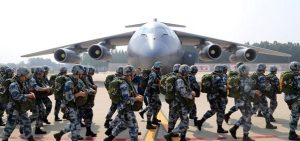
PLA Airborne Corps. Image: Global Times
PLAAF Doctrinal Shift
The PLAAF is the largest air force in the region and the third largest in the world, with more than 2,500 aircraft (not including UAVs or trainers), of which 1,700 are combat aircrafts. PLAAF is closing the gap with Western air forces across a broad spectrum of capabilities, such as aircraft performance, command and control, and electronic warfare. The 2017 reforms included establishing new airbases and a brigade based structure. The PLAAF also relocated and subordinated some units to different theatre commands and re-designated the 15th Airborne Corps as the PLA Airborne Corps. It is shifting its focus from territorial air defence to forward-postured offensive-defence. The PLAAF is boosting its capabilities for strategic early warning, long-range precision air strikes, air and missile defence, information countermeasures, airborne operations, strategic projection, and comprehensive support.
PLAAF Coming Out of Army Shadow
For China’s global ambitions, President Xi Jinping is driving air, space, and maritime capability. The Chinese air force now has service-specific strategies. The PLAAF primary missions now are air deterrence, air offensive, air blockade, maritime and ground force support operations. Air offensives would entail large-scale strikes with the goal of rapidly gaining air superiority, reducing an adversary’s capacity for military operations, and creating conditions for early victory. It would entail attacks on airfields and seaports as well as air, land, and sea transportation routes with the goal of cutting the enemy supply lines by attacking logistics facilities, and key choke points. It would also include battlefield close air support, strategic and theater airlift, and airborne operations.

J-20 Fifth Generation Aircraft. Image Source: Sina Weibo
Fighters
The PLAAF has nearly 1,000 fourth-generation fighters such as J-10, J-11B, J-16, Su-27, Su 30 MKK, and Su-35. The target is to retire remaining legacy fighters and become a fourth-generation-plus force within the next few years. The fifth-generation fighter aircraft, are the developmental Chinese J-20 and FC-31/J-31. China claims to have 150 J-20s. They carry integral weapons and are designed with network-centric warfare technology. China continues to struggle to develop suitable aero-engines.
Bombers
China’s bomber force comprises variants of the H-6 Badger bomber, and the PLAAF has worked to maintain and enhance their operational effectiveness. The extended-range H-6K variant features more efficient turbofan engines, and can carry six ALCMs, providing long-range, standoff, precision-strike capability. The PLAAF is developing new medium-to-long-range H-20 stealth bomber to strike regional and global targets. It is planned to reach initial operational clearance (IOC) by 2025.
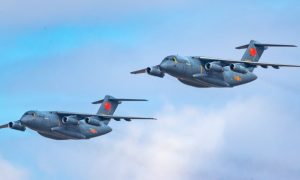
Y 20 aircraft. Image: AVIC
Transport Aircraft and Force Multipliers
China already has 60 Y-20 large transport aircraft to supplement the nearly 17 Russian Il-76 aircraft (40 tons). Y-20 can lift up to 66 tons and transport up to 2 Type 15 tanks or one Type 99A tank over a distance of 7800km. It uses the same Russian engines as the Il-76. The WS-20 engine is under development. Y 20 has air to air refueller and AEW&C variants. China currently has around 25 AEW&C of KJ-2000, KJ-200, and KJ-500 class. The largest being IL-76-based. These aircraft extend the range of a country’s integrated air defence system network. But the numbers are still too few for its continental size and possible confrontation with the USA. Similarly, China has only 20 FRA, including eight Xian YY-20A. Numbers will go up soon. China also has nearly 25 dedicated electronic warfare aircraft.
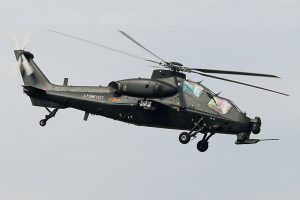
Z-10 Helicopter. Image: Wikipedia
Helicopters and Training Aircraft
The Z-10 attack helicopter has been co-designed with Kamov design bureau of Russia and is armed with HJ-10 Air-to-Ground Missile (AGM) similar to AGM-114 Hellfire. The Z-19 is the smaller variant. The Z-18 is a Chinese medium transport helicopter that can carry 27 troops or five tons of cargo. The Z-18J is the AEW variant. The Z-20 helicopter is the Chinese equivalent of Sikorsky S-70.
Nanchang CJ-6 has been the basic training aircraft for many decades. Hongdu JL-8 is the Jet trainer. The Karakorum K-8 variant of the same is with Pakistan and is being exported to many countries in Asia and Africa. Hongdu L-15 is a supersonic lead-in fighter trainer. Chian has done well in indigenous trainer production.
UAVs, UCAVs and Drones
China has a growing high-end military drone force backed by a large UAV industry, including private start-ups. They produce all genres of UAVs including stealth, VTOL, micro-UAVs, unmanned airships, flying wings, sailplanes, UFO-style flying discs and even ornithopters (flapping wings). PLAAF’s current in-service Medium Altitude Long Endurance (MALE) drone is the BZK-005 (Giant Eagle). The GJ-1 and GJ-2 are MALE UAVs capable of the strike role and are the variants of the export oriented Wing Loong I and Wing Loong II systems. They are considered equivalents of MQ-1 and MQ-9, respectively. PLAAF high-altitude (HALE) UAV is jet-powered WZ-7 (Divine Eagle). The GJ-11 (Sharp Sword) is the stealthy UCAV, and WZ-8, a supersonic reconnaissance UAVs. GJ-11 could be used for autonomous missions, autonomous swarming, manned-unmanned-teaming (MUMT), loyal wingman, and other concepts. The Divine Eagle AEW variant will augment existing manned AEW&C platforms. The “Anjian” (Dark Sword) UCAV is a delta-winged platform similar to the American Global Hawk HALE UAV. The CH-4 is a U.S. General Atomics MQ-9 Reaper look alike. CH-3 has a semi-active laser, and can carry Anti-Radiation Missile (ARM), and an Air-to-Surface Missile (ASM). The Pakistani Burraq UAV is based on CH3 UAV and been supported by China. Clearly China has a stable of home-made UAVs and are much ahead of India.
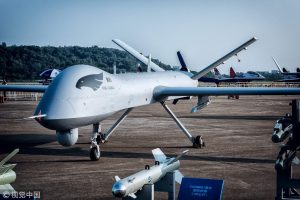
Wing Loong UCAV. Image: China Defence
Aerial Weapons and SAMs
PLAAF is developing smart, intelligent and precision ammunition with surgical strike capability. KD-88 is an IR/TV guided Air to Surface Missiles (ASM) for ground and sea targets with an estimated range is about 180 km. PLAAF has the supersonic Russian and Chinese made Anti-Radiation Missiles (KH 31P, YJ-91). There is an inventory of laser-guided and satellite-guided bombs. The top end Beyond Visual Range (BVR) Air-to-Air missiles (AAM) include the latest PL-12 and PL-21 which outrange the Western counterparts like AIM-120 AMRAAM, and Meteor. China also has many Russian R-27, R-77, and R-73 AAMs. The extended-range radar-guided PL-15 and PL-21 are termed as AWACS killers. China has nearly 500 DH-10 land-attack cruise missiles with a 2,000 km range. The air launch variants have 1,500 km range. PLAAF’s SAMs include Russian-sourced SA-20 (S-300PMU1/2) battalions and domestically produced CSA-9 (HQ-9) battalions. CSA-X-19 (HQ-19) is the domestically produced ballistic missile defence weapon. China has acquired six batteries of the Russian S-400 air defence systems.
Airborne Corps
The PLA Airborne Corps consists of six airborne brigades, a special operations brigade, an aviation brigade, and a support brigade, and is under PLAAF. The airborne troops are envisaged for pre-emptive attacks on the enemy’s key military targets in the rear area to disrupt preparations for an offensive. Currently, the PLAAF can lift one division of 11,000 men with light tanks and self-propelled artillery. Airborne Corps has demonstrated it can move a regiment plus of paratroopers with light armored vehicles to anywhere within China in less than 24 hours.
Joint Training and Exercises
PLAAF regularly exercises with other PLA ground and naval forces. These include large force engagements. They do regular exercises in Tibet region, and of late the frequency of exercises has increased even in winter. With Pakistan Air Force (PAF), PLAAF has been doing regular Shaheen series of exercises since 2011. The exercise helped the two sides for interoperability and gave the PAF exposure to the SU-30 capabilities. The F-16 were not allowed to be used by the Americans. However, Chinese have had adequate inputs about the F-16s during interaction with Pakistani pilots. There are also reports that some PLAAF pilots are learning to speak English. Nearly 60 percent of PAF aircraft and equipment is now of Chinese origin. Pakistan could offer some airbases to China during hostilities.
Key PLAAF Strategic Takeaways
Like all modern air forces, PLAAF places emphasis on long range offensive precision strikes using enablers like FRA, AWACS and satellites, and a combination of air and surface launched weapons. They are building synergy between the PLAAF and the People’s Liberation Army Rocket Force (PLARF). PLAAF is building multi-layered air defence systems and the ability to promulgate and enforce Air Defence Identification Zones (ADIZs) and ‘no fly zones’. PLAAF has increased capability to cover vast airspace in TAR and is increasing capability to look deep into Indian air space. China’s extensive constellation of surveillance satellites with short revisit cycles adds significant punch to target locating and tracking capability. China has a clear lead over India’s space programme. PLAAF’s increased focus on electronic warfare, cyber and other support forces like ‘base protection forces’ is meant to make the PLAAF a contemporary and modern force. The newly created PLA Strategic Support Force (SSF) also offers significant force multiplier support to the PLAAF. Indian armed forces are just beginning to harness the space, cyber and information warfare resources.
PLAAF believes in using high tech weaponry for force projection that would allow quick victory in “limited wars”. China would execute integrated deep strikes and concentration of superior firepower to destroy opponent’s retaliatory capabilities. This pro-active doctrine essentially seeks to take the battle into enemy territory. PLAAF doctrine also points towards the unification of air and space defences requiring integrated command and control.
PLAAF Vision 2035
China has achieved networking and information led operational capability and is working towards Artificial Intelligence (AI) backed intelligent warfare. There is significant progress in the research and development of sixth-generation fighter aircraft which will have artificial intelligence integrated systems and will fly in conjunction with drones. Aircraft is expected to be inducted by 2035. China is investing heavily to develop avionics and jet engines. China’s biggest strides are coming in air-to-air missiles. PLAAF believes that with a one or two million dollars weapon, they could destroy a few hundred-million-dollar AEW&C aircraft. China has already demonstrated and operationalised hypersonic weapons capability. China is pushing ahead in cyber, electronic warfare, space, quantum computing and some other technologies.
Implications and Options India
Indian Air Force (IAF) has a clear advantage of much larger number of airfields at much closer distances and at lower altitude. Even though IAF is currently at all-time low in numbers of fighter aircraft, it can currently field more missions across Himalayas. China is building more airfields and will use long-range vectors. IAF has much greater actual war exposure and is carrying out large number air exercises with all the major air forces of the world, which gives it clear training edge. India needs to rebuild IAF to 42 combat squadrons. While we need to accelerate development and production of indigenous fighters, the process of acquiring 114 fighters must be hastened. IAF also needs much greater number of AWACS and FRA aircraft. Surface-to-surface missiles and Cruise missile inventories must go up, and so has to be ammunition stocking. There is also a need to strengthen infrastructure along the Himalayan border, and at forward airfields. India needs to increase cyber and electronic warfare capability. The number of combat UAVs are inadequate to meet all challenges as of now. India needs many more satellites to increase ISR capabilities. India has to invest much for in defence R&D and new technologies and become ‘atmanirbhar’ in defence production. Considering that Chinese are literally sitting on our border, out of budget funding may be allotted to hasten purchases of critical capabilities. China is a closed society. A lot of what comes out from the Chinese controlled media is part of Information Warfare and Influence Operations (IWIO) to make adversary under confident. India must guard against this. With the fastest growing large economy, and high level of determination and training, India is well placed to take on any misadventure and must continue to be on guard.
Disclaimer
The opinions expressed in this article are the author’s own and do not reflect the views of Chanakya Forum. All information provided in this article including timeliness, completeness, accuracy, suitability or validity of information referenced therein, is the sole responsibility of the author. www.chanakyaforum.com does not assume any responsibility for the same.
Chanakya Forum is now on . Click here to join our channel (@ChanakyaForum) and stay updated with the latest headlines and articles.
Important
We work round the clock to bring you the finest articles and updates from around the world. There is a team that works tirelessly to ensure that you have a seamless reading experience. But all this costs money. Please support us so that we keep doing what we do best. Happy Reading
Support Us











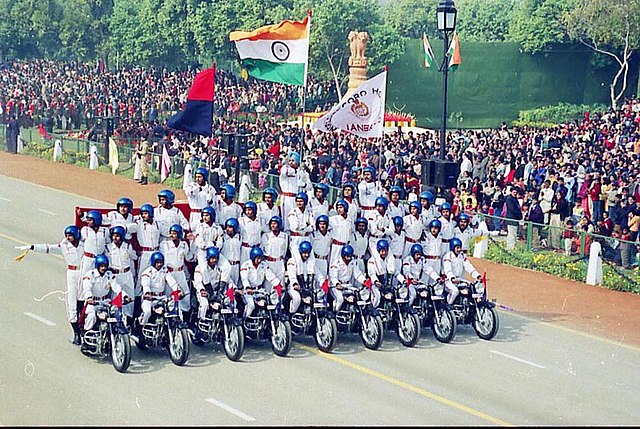



POST COMMENTS (1)
S K